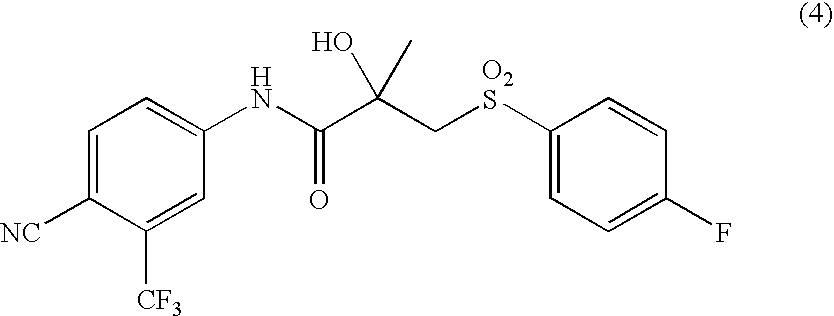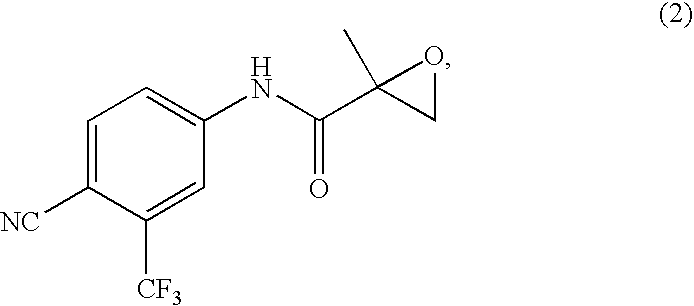Process for producing bicalutamide and method of purifying intermediate thereof
a technology of bicalutamide and intermediate, which is applied in the field of process for producing bicalutamide and a method of purifying an intermediate thereof, can solve the problems of difficult separation and removal of deoxy-sulfonyl compound from compound (4) after oxidation reaction
- Summary
- Abstract
- Description
- Claims
- Application Information
AI Technical Summary
Problems solved by technology
Method used
Image
Examples
example 1
[0112] Wet crystals of 4′-cyano-3-(4-fluorophenylthio)-2-hydroxy-2-methyl-3′-trifluoromethylpropionanilide (83.8 g; dry weight: 75.4 g) containing Deoxy-Sulfide Compound (0.19% (LC area percentage)) were added to toluene (377.1 ml), heated and dissolved. The solution was cooled down to 55° C. Seed crystals (10 mg) of 4′-cyano-3-(4-fluorophenylthio)-2-hydroxy-2-methyl-3′-trifluoromethylpropionanilide were added, and the solution was cooled to 50° C. over an hour. Then, the solution was cooled to 10° C. over 4 hours at a rate of 10° C. / hour. After stirring for 2 hours at 10° C., the product was filtered and washed with toluene (226 ml) cooled to 10° C. Upon drying at 47 to 48° C. under 2.4 to 2.7 kPa, purified crystals of 4′-cyano-3-(4-fluorophenylthio)-2-hydroxy-2-methyl-3′-trifluoromethylpropionanilide were obtained. The content of Deoxy-Sulfide Compound was 0.052% (LC area percentage). Conditions for HPLC: (SUMIPAX ODS A-212; acetonitrile / 0.1% aqueous acetic acid solution).
example 2
[0113] Purified crystals of 4′-cyano-3-(4-fluorophenylthio)-2-hydroxy-2-methyl-3′-trifluoromethylpropionanilide (10.0 g, 25.1 mmol) (containing 0.061% (LC area percentage) of Deoxy-Sulfide Compound) obtained in the same manner as in the above Example 1, phthalic anhydride (18.64 g, 125.6 mmol) and ethyl acetate (30 ml) were charged and heated to 50° C. 35% Aqueous hydrogen peroxide solution (5.4 g, 55.6 mmol) was added dropwise over 8 hours and the mixture was matured for 2 hours. Ethyl acetate (90 ml) was added and the mixture was cooled to 5° C. Na2SO3 (0.71 g) was dissolved in deionized water (6.1 ml), and the solution was added dropwise. After confirming absence of the per-oxy acid, the mixture was heated to 15° C. and 20% aqueous K2CO3 solution was added dropwise thereto for adjusting pH to 7.07. After washing with a solution prepared from NaCl (6.0 g), deionized water (60 ml) and K2CO3 (0.17 g), the solution (pH 7.58) was subjected to acid washing [35% HCl (1.5 g) and deionize...
example 3
[0114] N-methacryloyl-4-cyano-3-trifluoromethylaniline (57.3 g, 0.225 mol), ethyl acetate (340 ml) and phthalic anhydride (116.9 g, 0.789 mol) were charged and the mixture was heated to 50 to 55° C.
[0115] To the mixture was added dropwise 35% aqueous hydrogen peroxide solution (43.8 g, 0.451 mol) over 8 hours and the mixture was matured for 20 hours. After adding ethyl acetate (114 ml), the mixture was cooled to 15° C. and then aqueous solution (145 ml) of sodium sulfite (25.6 g) was added dropwise thereto.
[0116] After confirming absence of the per-oxy acid, 15% aqueous potassium hydroxide solution was added dropwise to the mixture, for adjusting pH to 7.3. Phases were separated and a layer was washed with a solution prepared from water (230 ml), sodium chloride (40.5 g) and 35% aqueous hydrochloric acid (0.23 g).
[0117] After concentrating the organic layer under reduced pressure, toluene (400 ml) was added and the layer was further concentrated. The concentrate obtained was comb...
PUM
| Property | Measurement | Unit |
|---|---|---|
| temperature | aaaaa | aaaaa |
| time | aaaaa | aaaaa |
| temperature | aaaaa | aaaaa |
Abstract
Description
Claims
Application Information
 Login to View More
Login to View More - R&D
- Intellectual Property
- Life Sciences
- Materials
- Tech Scout
- Unparalleled Data Quality
- Higher Quality Content
- 60% Fewer Hallucinations
Browse by: Latest US Patents, China's latest patents, Technical Efficacy Thesaurus, Application Domain, Technology Topic, Popular Technical Reports.
© 2025 PatSnap. All rights reserved.Legal|Privacy policy|Modern Slavery Act Transparency Statement|Sitemap|About US| Contact US: help@patsnap.com



